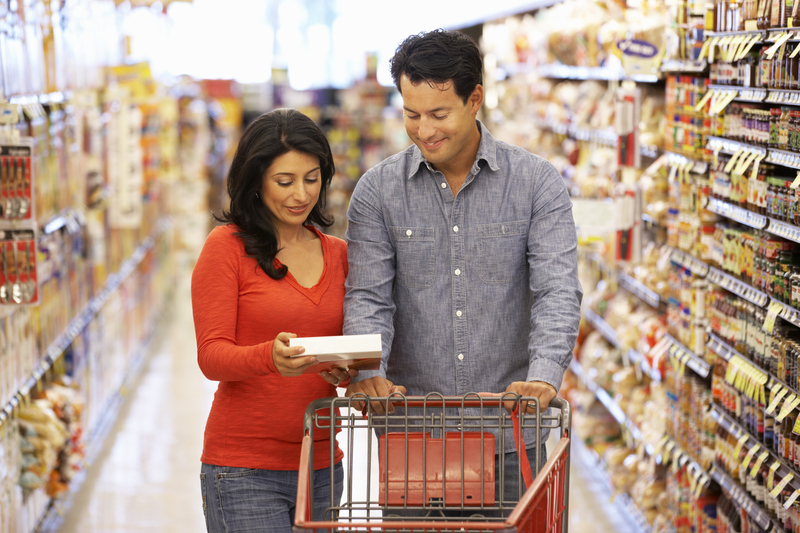When shoppers enter a grocery store to buy food and other essentials, they often rely on overhead signs to direct them to various product aisles. Few of them are aware of the thought that goes into store layouts. Of course, store layouts are important for all types of retailers, not just supermarkets; however, the variety of items carried by supermarkets makes planograms especially important. Freelance writer Alexandra Sheehan (@thealexsheehan) explains, “A planogram is a visual merchandising tool. Planograms are detailed drawings of your store layout with special attention on product placement. Merriam-Webster defines it as such: ‘a schematic drawing or plan for displaying merchandise in a store so as to maximize sales.’ In addition to being a visual representation of your store’s aisles, displays, and point-of-sale, for example, a planogram will show you exactly where specific products are placed. The information in a planogram is thorough; it’ll demonstrate the exact shelf an item is kept.”[1]
While many stores were shuttered during the early months of the pandemic, for obvious reasons, supermarkets and grocery stores remained open. It became clear, as panic buying set in during those early days, that product inventory was going to have change to stay in touch with consumer demands. As a result, planogram design has continued to play an important role in grocery sales.
How the pandemic changed supermarket planograms
Michael Browne (@mbtravel) the Executive Editor of Supermarket News, reports, “Center store dollar sales are up by more than 10% among more than half of grocery retailers in 2020, according to Supermarket News’ 2020 Center Store Trends Survey, with a total of 86% of retailer respondents saying they expect to see an increase in sales in the category in 2020 versus 2019.”[2] However, that’s not the whole story. Browne continues, “Within center store, there has been a significant shift in what consumers have been buying this year during COVID-19. While snacks, beverages, groceries and beer/alcohol have been traditional leaders in the category, in 2020 retailers reported that the center store categories having the most success during the pandemic are household cleaners (mentioned by 73% of retailers), paper goods (71%), frozen food (63%) and shelf-stable food/grocery (60%). No surprise there, given the run on toilet paper and cleaning supplies during the initial outbreak of coronavirus.”
The center store has always been important to grocers because getting consumers into the center store means they must pass by a lot of products they might not have specifically targeted for purchase. So it matters — a lot — where products are located in a store as well as where they are placed on the shelf. Ron Hughes, Senior Manager of shopper strategy and innovation at the Coca-Cola Co., explains, “Center store absolutely has an important role to play in large stores, and research shows that this area of the store is a key profit driver — 75 percent to 80 percent of grocery bottom-line profit is contributed by center store.”[3] Browne reports the center store, during the pandemic, has not always been in the store; sometimes the center store can be found at the curb. He explains, “The explosion in online grocery sales spurred by the pandemic has impacted center store in a number of ways. When asked what steps retailers are taking to increase center store sales, the overwhelming response was offering at-home delivery and/or curbside pickup at 68%.” Nevertheless, most grocery shoppers still prefer shopping in the store, which means planograms still play an important role.
The importance of planogram design
Historically, products placed at eye-level sell better than products placed at other heights. Understanding why they sell better is common sense — you don’t need advanced analytics to tell you why. Also, the first products consumers see when entering an aisle (the “major”) can help entice consumers to shop that aisle. Unfortunately, not everything can be placed at eye-level or in a major position. Fortunately, analytics can help determine the best placement of items failing to gain pride of place. When discussing planograms, another oft-heard term is facings. Facings are nothing more than a row of products. Traditionally, a retailer’s best-selling and most-profitable products receive the greatest number of facings. Facing allocations are not static. They can be updated seasonally, or to coincide with special events and/or with new assortments. Planograms also help retailer’s display products in a logical shopper-friendly fashion.
Retail expert Matthew Hudson (@hudsonhead) notes, “The complexity of a planogram may vary by the size of the store, the software used to create the planogram, and the need of the retailer.”[4] He adds, “Product placement and improved sales are just two very basic reasons a retailer should be implementing planograms in their shops.” Other benefits, Hudson explains, include: Improving the selling potential of every square foot of space; improving inventory control and decreasing out-of-stocks; easing product replenishment tasks; and making better product positioning decisions. Most software planogram solutions, like the Enterra Planogram Solution, attempt to answer the following questions:
- How much aisle space should be allocated to each sub-category (e.g., shampoo, conditioner, coloring, hair sprays, mousse, serums, ethnic, etc.)?
- Within a sub-category, how much space should each brand receive?
- What is the right mix of new versus returning products?
After answers to those answers are determined, the planogram’s sections must be allocated. Retailers usually section by either brand or sub-category. Either way, the questions are the same:
- What section should be the major and minor (the section opposite the major) of the aisle?
- Do any sectional adjacencies seem to make a sales difference (positively or negatively)?
To answer those questions, today’s grocers rely heavily on big data and advanced analytics embedded in cognitive technologies. Mike Moussallem (@MikeMoussallem), a partner at Explorer Research, suggest ten points of data planograms should take into consideration. They are:
- Products that should be placed at eye level. “Eye tracking research consistently demonstrates that shelves at eye level tend to receive the most attention. … In addition to being physically problematic for some people to reach, lower shelves suffer from poor lighting, recessed packaging, and visual blocks thus reducing the attention paid to them.”
- Landmark Products. “Popular landmark products should be spread throughout your space. Because shoppers tend to gaze in a tight Z pattern starting with the landmark products, this strategy will nudge shoppers to gaze at more of your products.”
- Lean Right: “Take advantage of the human subconscious navigational tendency to look and go right. Place innovative or key strategic products to the right of landmark products.”
- Category Drivers: “Arrange key category drivers in the center of the space so that products needing high visibility can take advantage of the Z-gaze.”
- Create Vertical Blocking: “Where appropriate, place products vertically on several shelves rather than horizontally across one shelf. Because vertical blocking is generally preferred to horizontal blocking, you can use the block to draw attention to a greater number of smaller line extensions or innovations.”
- Create Gaze Plots: “When appropriate, position landmark products to create a blocking strategy that will influence the gaze towards specific, less known or new products.”
- Adjacencies. “Consider product adjacencies. Some products can have a distinctly positive or negative impact on the performance of specific items and even the entire shelf.”
- Layout Chunking: “Where shelving layouts deviate from straight lines with clear paths, consider how the area is chunked.”
- Sign Chunking: “Consider how signage may impact how shoppers chunk the shelf. Some placements may chunk sections in less advantageous ways and create barriers that automatically deselect products.”
- Focus: “A more focused assortment of products can often be better both financially and behaviorally. Products are easier for customers to find thereby increasing purchase rates.”
He concludes, “By understanding some of the science, you will have the confidence to know that your shopper needs are more likely to be satisfied and that the shelf space is being optimized for business results.”[5]
Concluding thoughts
Sterling Ross-Harrington, a Senior Account Manager at SMSB Consulting Group, observes, “Over time planograms can aid in comparing products from season to season. Which skus sold or which ones barely moved from their shelves? Did a different location on the wall increase or decrease its sales? How do similar products compare to their competitors? These are all questions which can be answered through analytics and reports supplied by planograms; ultimately determining which brand could receive an extra foot of space in the future, and which brand could be downsizing.”[6] Advanced analytics and cognitive technologies bring planogram design out of the Industrial Age and into the Digital Age.
Footnotes
[1] Alexandra Sheehan, “Planograms: What They Are and How They’re Used in Visual Merchandising,” Shopify Retail Blog, 27 June 2018.
[2] Michael Browne, “Center store staying strong, but with a whole different product mix,” Supermarket News, 1 October 2020.
[3] Bridget Goldschmidt, “5 Ways to Keep Center Store Relevant,” Progressive Grocer, 18 December 2017.
[4] Matthew Hudson, “How to Create and Use a Retail Planogram,” The Balance Small Business, 21 November 2019.
[5] Mike Moussallem, “10 Principles for a Successful Retail Shelf Planogram in 2020,” Explorer Research, 7 November 2019.
[6] Sterling Ross-Harrington, “Planograms: Where Merchandising Meets Analytics,” SMSB, 2 June 2020.





